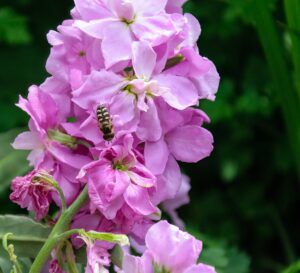Stock flower, scientifically known as Matthiola, are popular annual or biennial flowering plants that belong to the Brassicaceae family. These charming and fragrant flowers are native to the Mediterranean region, particularly Greece and Italy. The name “stock” is derived from the Old English word “stoc” or “stocc,” which means a short, stocky plant.
Stock flowers are known for their dense clusters of blooms that grow on tall, upright stems. They come in a variety of vibrant colors, including white, pink, purple, red, and yellow. The flowers have a distinctive spicy, clove-like fragrance, making them a favorite choice for cut flower arrangements and perfumes. You can also read this for more information
Introduction
These plants typically reach a height of about 1 to 3 feet (30 to 90 centimeters), depending on the variety. The foliage is narrow and lance-shaped, with a gray-green hue that adds an attractive backdrop to the colorful flowers. The leaves grow in a dense rosette formation at the base of the plant and along the stems. The leaves of stock flowers typically range from 2 to 6 inches (5 to 15 centimeters) in length, and 0.5 to 1 inch (1 to 2.5 centimeters) wide.
Stock flowers, have dense clusters of blossoms on upright stems, creating a full appearance. The flowers are typically 1 to 2 inches in diameter and can be single or double with velvety petals in various colors like white, pink, lavender, purple, red, and yellow. Some even have bicolor or multicolor patterns. The stock flowers also emit a captivating fragrance resembling cloves or honey, making them popular for perfumes and potpourri. With their symmetrical arrangement and striking display, stock flowers add charm to gardens and bouquets alike.
Stock flowers are versatile and can be grown in gardens, containers, or used as border plants. They prefer cool climates and thrive in well-draining soil with full sun or partial shade. The plants are known for their resilience and can tolerate mild frost.

Cultivars of Stock Flower
Stock flowers (Matthiola) have a wide range of cultivars available, each with its unique characteristics and features. Here are some popular cultivars of stock flowers:
‘Cinderella’: This variety of stock flowers produces large, double blooms in shades of pink, lavender, and white. It has a strong and delightful fragrance.
‘Ten Week’: As the name suggests, this cultivar is known for its early blooming period, typically flowering within ten weeks of sowing. It offers a mix of colors, including white, pink, purple, and red.
‘Evening Scented’: This stock flower cultivar is favored for its intensely fragrant blossoms that emit a scent most potent in the evening. The flowers are typically shades of mauve and purple.
‘Vintage Mix’: This cultivar features a blend of pastel-colored flowers, including soft pinks, purples, and whites. The blooms are double and carry a pleasant fragrance.
‘Matthiola Incana’: Also known as Brompton stock, this cultivar offers a variety of colors and is characterized by its strong, spicy fragrance. It produces dense clusters of single or double blooms.
‘Harlequin’: This stock flower cultivar stands out for its distinctive bicolor petals. The flowers display a combination of white and contrasting colors, such as purple or pink.
‘Sunset’: With its warm hues of orange, red, and yellow, this cultivar adds a vibrant touch to gardens. The flowers are usually single with a delightful fragrance.

Sunlight requirements of stock flower
Stock flowers (Matthiola) generally prefer full sun to thrive and produce their best blooms. They have moderate to high sunlight requirements and benefit from at least 6 to 8 hours of direct sunlight per day. Adequate sunlight is essential for their growth, flowering, and overall health.
When selecting a location for planting stock flowers, choose a spot that receives ample sunlight throughout the day. This can be in a sunny garden bed, along a south-facing wall, or in an open area without significant shade from buildings or trees.
Insufficient sunlight can lead to weak growth, reduced flower production, and leggy or spindly plants. In areas with extremely hot or scorching climates, some partial shade during the hottest part of the day can be beneficial to protect the plants from excessive heat stress.
Temperature and Humidity requirements
Stock flowers are considered cool-season annuals or biennials. They prefer moderate temperatures and perform best in regions with mild climates. The ideal temperature range for stock flowers is between 55°F to 75°F (13°C to 24°C). They can tolerate some fluctuations in temperature, but extreme heat or cold can negatively impact their growth and flowering. In hotter climates, providing partial shade during the hottest part of the day can help protect the plants from heat stress.
Stock flowers are relatively adaptable when it comes to humidity levels and can tolerate a range of conditions. They generally prefer moderate humidity levels, but they can handle both dry and slightly humid environments. High humidity, especially in combination with warm temperatures, may increase the risk of fungal diseases, so ensuring good air circulation around the plants can be beneficial.
Soil Requirements
Stock flowers thrive in well-draining loamy or sandy soil with a slightly acidic to neutral pH of 6.0 to 7.0. Incorporating organic matter like compost or well-rotted manure improves soil structure, drainage, aeration, and nutrient content. Fertile soil is beneficial, so use a balanced, slow-release, or all-purpose fertilizer before planting. Ensuring proper soil drainage is crucial to prevent root rot, so avoid heavy clay soils and amend with materials like sand or perlite if needed. Keep the soil consistently moist but not waterlogged, using regular watering and mulching for moisture retention. Prepare the soil by removing debris, weeds, and rocks, and loosen it for improved aeration and root growth.
Propagation
Seed Sowing
Stock flowers are commonly grown from seeds, and this method is the most popular and straightforward way to propagate them.
Start by sowing the seeds indoors in trays or pots, 6-8 weeks before the last frost date in your region. Sow the seeds on the surface of a moist, well-draining seed-starting mix, and lightly press them into the soil.
Maintain a temperature of around 65°F to 75°F (18°C to 24°C) for optimal germination.
Keep the soil consistently moist but not waterlogged, and provide bright indirect light for seedling growth.
Once the seedlings have developed a few sets of true leaves, they can be transplanted into larger containers or outdoor garden beds. For more details read
Water Requirements
Stock flowers benefit from regular, deep watering to maintain even soil moisture without overwatering. Adjust the watering frequency based on climate, soil type, and plant needs. Typically, providing water every 2-3 days is a good starting point. Allow the top inch (2.5 cm) of soil to dry out slightly between watering. Deep watering promotes strong root development. Apply organic mulch to conserve moisture, regulate soil temperature, and suppress weeds. During hot and dry periods, increase watering to prevent wilting. Monitor soil moisture and adjust watering accordingly to ensure healthy stock flowers.
Fertilizer Requirement of Stock flower
Prior to planting stock flowers, incorporate a balanced, slow-release, or all-purpose fertilizer into the soil. Choose a fertilizer with a balanced ratio of nitrogen, phosphorus, and potassium. Apply the initial dose during soil preparation and subsequent applications every 4-6 weeks during the growing season. Dilute the fertilizer in water and apply it around the base of the plants, avoiding foliage contact. Water the plants after fertilizing. Organic options like compost, fish emulsion, or seaweed extract can be used. Avoid over-fertilization to prevent excessive foliage growth. Follow package instructions and recommended application rates to maintain nutrient balance and avoid damage to the plants.
Pinching
Pinch or cut back the central stem of the stock flower plant when it reaches a certain height, typically around 6 to 8 inches (15 to 20 centimeters). This encourages branching and the development of lateral shoots. After pinching, the plant will redirect its energy toward the lateral shoots, resulting in the growth of multiple side branches. These lateral shoots will eventually produce additional flower clusters. Regularly remove spent flowers by deadheading to promote continuous blooming and prevent the plant from diverting energy toward seed production.
Staking
As the plant grows and produces more flowers, it may require additional support to prevent the stems from bending or breaking. Use stakes or cages to provide support and maintain an upright growth habit. The large cultivars that are used for cut flower production also need staking.
Problems with Stock Flower
Stock flowers (Matthiola incana) are susceptible to various diseases that can impact their health and appearance.
Disease Attack
Here are some common diseases that can affect stock flowers and their characteristics:
Powdery Mildew (Erysiphe cichoracearum):
Powdery mildew appears as a white or grayish powdery growth on the leaves, stems, and flowers of stock plants. It can cause curling, distortion, and stunted growth of affected plant parts.
Fusarium Wilt (Fusarium oxysporum):
Infected plants show wilting, yellowing, and eventual death of the foliage. The lower leaves are often affected first, and the stems may exhibit brown discoloration. Unfortunately, there are no effective chemical treatments for Fusarium wilt. Prevention is key, so select disease-resistant stock varieties and ensure proper plant hygiene and cultural practices.
Botrytis Blight (Botrytis cinerea):
Botrytis blight causes brownish-gray, water-soaked spots on the flowers, leaves, and stems of stock plants. The affected plant parts may develop a fuzzy gray mold as the disease progresses. Remove and discard infected plant material promptly. Maintain good airflow and reduce humidity around the plants. Fungicides labeled for Botrytis control can be used as preventive measures.
Root Rots (Pythium spp. and Rhizoctonia solani):
Affected stock plants may exhibit stunted growth, yellowing of foliage, wilting, and root decay. The roots may appear discolored, soft, and mushy. Proper drainage and avoiding overwatering are crucial to prevent root rots. Use well-draining soil and avoid excessive irrigation. Fungicides labeled for root rot control can be applied as a preventive measure.
It’s important to note that the best approach to disease management is prevention. Maintaining healthy growing conditions, including proper watering, adequate spacing, and good sanitation practices, will help reduce the risk of disease attacks. Additionally, selecting disease-resistant stock varieties can be beneficial in preventing major disease outbreaks. If you suspect a disease infestation on your stock flowers, it is recommended to consult with a local gardening expert or extension service for accurate identification and specific management recommendations based on your region’s conditions.
Stock flowers (Matthiola incana) can be susceptible to various insect pests that can cause damage to the plants. Here are some common insect pests that may attack stock flowers and their characteristics:
Insect Attack on Stock Flower
Aphids:
Aphids are small, soft-bodied insects that come in various colors (green, black, brown, or red). They feed by sucking sap from the leaves and stems, causing curling, wilting, and stunted growth. Regularly inspect the plants and use strong jets of water to dislodge aphids from the foliage. Beneficial insects like ladybugs and lacewings can also help control aphid populations. In severe cases, insecticidal soaps or neem oil can be used following the product instructions.
Thrips:
Thrips are tiny, slender insects with fringed wings. They feed on plant tissues by piercing and sucking, causing silver streaks or speckling on the leaves and flowers. Neem oil or insecticidal soaps can be used as a chemical control measure.
Spider Mites:
Spider mites are very small arachnids that feed on plant cells by piercing and sucking. They cause yellowing, stippling, and webbing on the leaves. Regularly misting the plants to increase humidity can help deter spider mites. Beneficial predators like predatory mites and ladybugs can be introduced to control populations. Insecticidal soaps or neem oil can be used as a chemical control method.
Whiteflies:
Whiteflies are small, white insects that resemble tiny moths. They congregate on the undersides of leaves and suck sap from the plant, leading to wilting and yellowing of leaves. Use yellow sticky traps to capture adult whiteflies. Encourage natural enemies like parasitic wasps. Neem oil or insecticidal soaps can be used for control.
Caterpillars:
Various caterpillar species can feed on stock flowers, causing chewed leaves and flowers. Handpick and remove caterpillars when spotted. Bacillus thuringiensis (Bt) is an effective and environmentally friendly insecticide for caterpillar control.
Regular monitoring of your stock flowers is essential to catch insect infestations early. Integrated Pest Management (IPM) practices, which combine cultural, mechanical, biological, and chemical control methods, can help manage insect pests effectively while minimizing environmental impact. Always follow the instructions on any insecticide product and use them judiciously, as indiscriminate use of chemicals can harm beneficial insects and pollinators.
Uses of Stock Flowers
Stock flowers (Matthiola) have various uses due to their beautiful blooms and captivating fragrance. Here are some common uses of stock flowers:
Cut Flower Arrangements: Stock flowers are popular choices for cut flower arrangements due to their long-lasting blooms and delightful fragrance. The dense clusters of flowers create an attractive and visually striking display in bouquets and floral designs.

Stock cut flower in market
Perfume and Fragrance: The sweet and spicy scent of stock flowers makes them highly sought after in the fragrance industry. Flowers are often used in the production of perfumes, potpourri, and scented products like candles and sachets.
Garden Borders and Beds: Stock flowers can be planted in garden borders and beds to add color and fragrance to outdoor spaces. Their compact growth habit and range of vibrant colors make them an excellent choice for creating beautiful flower beds or lining garden pathways. Combine with other flowers like Petunia and Dianthus also give a great aesthetic look.
Cottage Gardens: With their old-fashioned charm and fragrance, stock flowers are commonly found in cottage gardens. Their classic appearance and sweet scent complement the nostalgic and romantic atmosphere of cottage-style landscapes.
Pollinator Attraction: The nectar-rich flowers of stock plants attract pollinators such as bees and butterflies to the garden. Planting stock flowers can help support pollinator populations and contribute to a thriving ecosystem.
Potpourri and Dried Flower Crafts: The petals of stock flowers can be dried and used in potpourri blends or incorporated into various dried flower crafts like wreaths, sachets, and floral arrangements.
Edible Decorations: Some varieties of stock flowers are edible, and their petals can be used as decorative accents on cakes, salads, and other culinary creations. Ensure that the flowers are grown organically and are safe for consumption.



